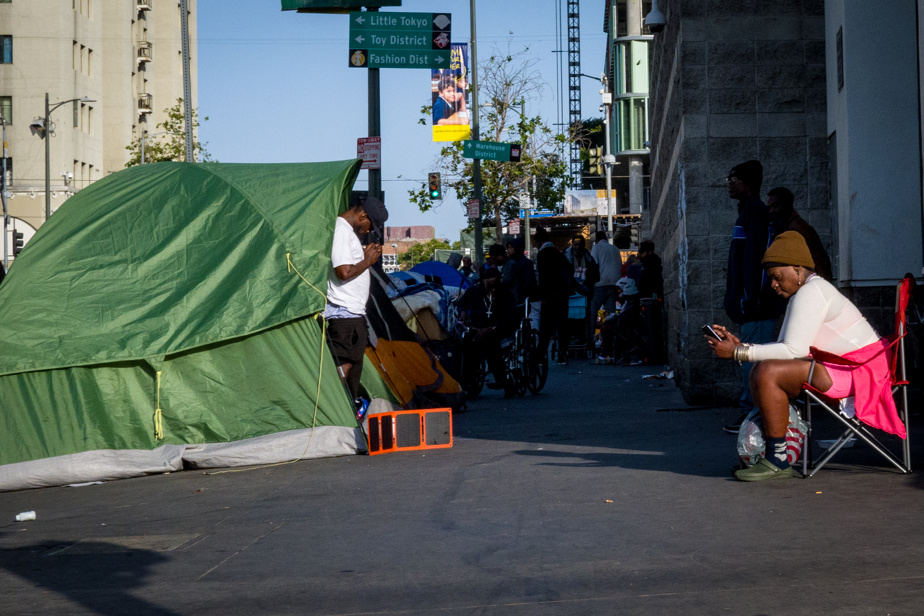(Los Angeles, Skid Row) In the poorest neighborhood of Los Angeles, it is impossible to use the sidewalks. Everywhere, they are cluttered with tents and other makeshift shelters where 4,400 homeless people live, a few kilometers from the glamor of Hollywood and the palaces of Beverly Hills.
We are at the epicenter of the homelessness crisis in the United States. Street after street, over more than a square kilometer, the camps follow one another. As if all the sidewalks of Old Montreal were covered with tents.
Those who survive in these conditions seem to evolve in a parallel universe. Crack, fentanyl, methamphetamine and xylazine take their toll, as do mental health issues.
Some walk around with their eyes staring into space like zombies. Others dance to music that only they can hear, laughing and moving their limbs in all directions like disjointed puppets.
Between the piles of heterogeneous objects and the ashes of the campfires that are lit there in the evening, surrounded by more or less threatening dogs, some greet us with a smug smile, while others insult us angrily.
No one hides to smoke their crack, even in the presence of the police, even when there are children.
Sieglinde von Deffner walks quickly, while avoiding puddles of urine, excrement, syringes and other trash on the ground, impassive despite the nauseating odor that hits the throat. It’s impossible for this dynamic blonde, who has worked in the area for 20 years for the Los Angeles County Health Department, to walk more than one street corner without being stopped by someone who wants help, a housing or another service.
Here, a man says he was kicked out of a shelter because he broke the rules. Further on, another complains about conditions that are too strict in a hotel purchased by the City to house homeless people.
Are these two men lying on the sidewalk asleep, or in distress, or downright dead? The worker calls out to them to check if they are breathing. Reassured to see them moving, she continues on her way.
At the bend of a building, we come across a municipal team dismantling the camps on a section of street. In white overalls and orange or yellow bibs, sometimes masked and gloved, protected by police officers, City employees throw everything that remained on the sidewalk into a dump truck, before cleaning the area with a jet of water. under pressure.
The City of Los Angeles regularly clears encampments, even though those living there have nowhere to go: homeless shelters are full. In principle, notices are distributed at the scene 72 hours before the operation.
Not far away, two toddlers are playing near a tent. Families who find themselves on the street obtain places in a shelter as a priority, but the establishment which welcomes them is under renovation, which prevents them from staying there during the day, explains Sieglinde von Deffner.
Los Angeles declared a state of emergency over homelessness in December 2022, amid an explosion of encampments. According to a count conducted in January 2023, 75,000 people live outdoors in Los Angeles County, which includes 37 municipalities and 9.7 million residents.
With funds from a special sales tax since 2017 intended to combat homelessness, the City and County have purchased and rented hotels and motels to house the homeless, and released millions to build social housing. , created tiny house villages, hired employees to improve the follow-up of files, in particular.
They pride themselves on having found permanent housing for 108,969 people, temporary places for 148,740 people and having prevented 34,265 from falling into homelessness since that time.
But on the ground, observers say they still see so many camps, and the shelters continue to overflow.
“I would love to have housing, or even a place in a shelter, but it takes forever,” laments Wade Herder, 57, who has been sleeping on park benches or on the ground for ten years.
The itinerant man, met on the grounds of a church which was hosting mobile showers that day, in Pasadena, a wealthy suburb of L.A., was robbed several times. But what does he find hardest in the life he leads? “Find a place to pee!” », he replies.




